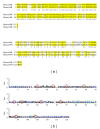Midkine in inflammation
- PMID: 22235180
- PMCID: PMC3253530
- DOI: 10.1100/2011/517152
Midkine in inflammation
Abstract
The 13 kDa heparin-binding growth factor midkine (MK) was originally identified as a molecule involved in the orchestration of embryonic development. Recent studies provided evidence for a new role of MK in acute and chronic inflammatory processes. Accordingly, several inflammatory diseases including nephritis, arthritis, atherosclerosis, colitis, and autoimmune encephalitis have been shown to be alleviated in the absence of MK in animal models. Reduced leukocyte recruitment to the sites of inflammation was found to be one important mechanism attenuating chronic inflammation when MK was absent. Furthermore, MK was found to modulate expression of proinflammatory cytokines and the expansion of regulatory T-cells. Here, we review the current understanding of the role of MK in different inflammatory disorders and summarize the knowledge of MK biology.
Keywords: Leukocytes; cytokines; immunity..
Figures


References
-
- Kadomatsu K, Tomomura M, Muramatsu T. cDNA cloning and sequencing of a new gene intensely expressed in early differentiation stages of embryonal carcinoma cells and in mid-gestation period of mouse embryogenesis. Biochemical and Biophysical Research Communications. 1988;3:1312–1318. - PubMed
-
- O’Brien T, Cranston D, Fuggle S, Bicknell R, Harris AL. The angiogenic factor midkine is expressed in bladder cancer, and overexpression correlates with a poor outcome in patients with invasive cancers. Cancer Research. 1996;56(11):2515–2518. - PubMed
-
- Ruan M, Ji T, Wu Z, Zhou J, Zhang C. Evaluation of expression of midkine in oral squamous cell carcinoma and its correlation with tumour angiogenesis. International Journal of Oral and Maxillofacial Surgery. 2007;36(2):159–164. - PubMed
-
- Mashour GA, Ratner N, Khan GA, Wang HL, Martuza RL, Kurtz A. The angiogenic factor midkine is aberrantly expressed in NF1-deficient Schwann cells and is a mitogen for neurofibroma-derived cells. Oncogene. 2001;20(1):97–105. - PubMed
Publication types
MeSH terms
Substances
LinkOut - more resources
Full Text Sources
Other Literature Sources

